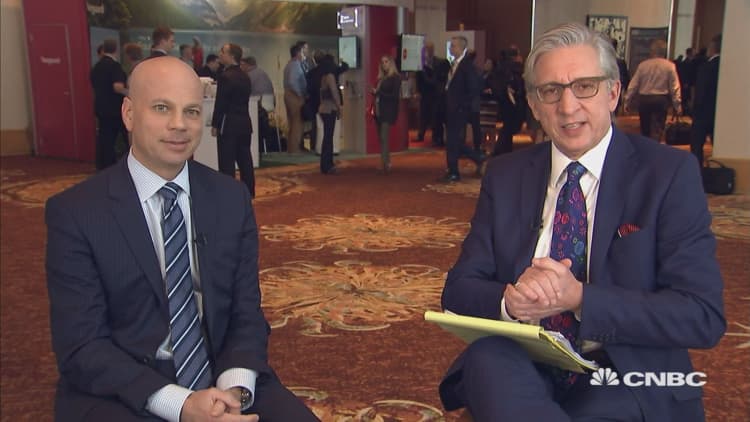Many investors follow Warren Buffett with the goal of uncovering secrets to investing. But no such secrets exist, says Larry Swedroe, director of research at BAM Alliance. Buffett has earned his success, but it's attributable to identification of key characteristics that can deliver above-market returns. These are not hidden. There is now even a term for it, which Swedroe, among others, has written about: factor-based investing.
Smart investors now know they don't have to pay active managers to identify factors that can lead to outperformance. The market continues to see a huge shift in investor interest away from higher-fee active investing and into lower-cost, market-weighted core equity index funds.
Investing in an S&P 500 index fund works, as Buffett reminds investors often — and he has long said it's getting harder to beat. The massive outflows from actively managed mutual funds is not slowing. In 2016 index fund king Vanguard saw more net inflows than all of its active fund company competitors combined — $289 billion to $244 billion.
More from ETF Strategist:
A critical move to make before a market correction
The best options for investors seeking safety and income
Why Warren Buffett violates his No. 1 rule of investing all the time
But the popularity of factor-based investing and smart beta ETFs show that there are additional ways to invest without paying an active manager. Inflows to smart beta ETFs exceeded $52 billion in 2016, and total smart beta assets hit $559 billion by the end of the year, according to Morningstar. Smart beta ETFs go back at least a decade, and hundreds of options exist under the umbrella — depending on your exact definition.
After eight consecutive years of a bull market that has returned 250 percent for the S&P 500 since the recession ended in 2009, it makes sense to be worried about a downturn. That can make active management seem appealing. Active managers certainly want to entice investors using that fear. And down markets are when active manager tend to do better versus an index.
Here are a few ideas that fall under the broad smart beta umbrella that can bridge the gap between traditional core market-weighted equity index investing and ideas more often associated with active managers.

1. Get high (dividends)
Dividends serve many masters: stable companies and cash flow, and uncertainty hedge, if they are not in rate-sensitive sectors. That is poised to be more important as the Fed is expected to raise rates this week.
One good option is the PowerShares S&P 500 High Dividend Low Volatility Portfolio (), which looks at the 75 highest dividend-yielding stocks in the S&P 500 and then invests in the 50 it deems the least volatile. Todd Rosenbluth, senior director of ETF and mutual fund research at CFRA, noted that SPHD is designed to do well in uncertain markets. But unlike active managers, the $3 billion ETF only charges 30 basis points. This fund has a healthy $3.1 billion in assets, and has returned more than 19 percent in the past year.
Neena Mishra, director of ETF research at Zacks Investment Research, favors the iShares Core Dividend Growth ETF (DGRO), among all smart beta ETFs. This $1.3 billion fund charges only 8 basis points and has returned 22.2 percent over the past year.
"It holds companies that have a history of consistently growing their dividends and are likely to continue growing dividends," Mishra said. "Companies with uninterrupted dividend growth record usually have solid balance sheets and strong cash flows," she said.
The stability and downside protection during market downturns, in addition to growing income streams, is her focus. And the ETF doesn't have a lot of exposure to rate-sensitive sectors, so it would be a good choice for investors worried about the rising rate environment, Mishra said. Sectors like utilities, real estate and telecom outperform in low-rate environments as an equity market alternative to bonds, but when rates are rising, they lose their biggest appeal as stocks.
2. Seek less risky stocks in each sector
BlackRock's iShares Edge MSCI Min Vol USA ETF (USMV) is another fund designed to minimize volatility. "You get exposure to the least risky stocks in every sector," Rosenbluth said. Though the fund is heaviest in the financial and health-care sectors, it is broadly diversified and one of the larger smart beta ETFs in total assets, at $12.4 billion. Plus, USMV charges 15 basis points and has returned 15.8 percent over the past year. "It looks good to us," Rosenbluth said.
Smart beta ETFs and benchmarks
| ETF | 1-year (%) | 3-year (%) | 5-year (%) |
|---|---|---|---|
| iShares Russell 1000 Value | 23.4 | 29.6 | 88.9 |
| Russell 1000 | 21.5 | 32 | 89.9 |
| PowerShares Dynamic Market Portfolio | 19.6 | 20.1 | 91.1 |
| S&P 500 | 21.4 | 33.8 | 91 |
| Guggenheim S&P 500 Equal Weight | 20.8 | 28.7 | 91.1 |
| S&P 500 | 21.4 | 33.8 | 91 |
| PowerShares FTSE RAFI 1000 | 22.7 | 29.9 | 91.2 |
| Russell 1000 | 21.5 | 32 | 89.9 |
| WisdomTree MidCap Dividend | 19.9 | 35.8 | 99.5 |
| S&P MidCap 400 | 24.6 | 27.4 | 84.1 |
(Source for performance data: XTF.com; ETFs chosen based on ETF.com history of smart beta development.)
3. Base decisions on more than one investing factor
The Goldman Sachs ActiveBeta U.S. Large Cap Equity ETF (GSLC) has a low fee, 9 basis points, and that has helped it attract more than $1.5 billion since its launch in 2015. Rosenbluth said that GSLC uses a combination of factors that typically perform well — value, momentum, quality and low volatility. "It's not a broad market fund, but you pay about the same in fees," he said.
"These factors tend to outperform in different market conditions, and, in fact, value and momentum tend to complement each other," Mishra, another fan of GSLC, said. "By combining those different factors, this ETF has a good chance of outperforming the market over the long term." The fund has returned more than 17.3 percent over the past 12 months.
Not all are very transparent and simple to understand. I like smart beta ETFs that follow transparent and easy-to-understand strategies and are not too expensive.Neena Mishradirector of ETF research at Zacks Investment Research
Mishra said there is a risk in factor investing. Factors like low volatility, high beta and momentum outperform only in certain market conditions. "Many smart beta strategies are based on market anomalies and those anomalies disappear if too many investors chase them," Mishra said. She added, "While smart beta ETFs follow rules-based methodologies, not all are very transparent and simple to understand. I like smart beta ETFs that follow transparent and easy-to-understand strategies and are not too expensive."
Not all ETF experts are fans of smart beta. "Funds that select or weight constituents using non-market cap-based methods that come out of investment research appeal to investors because of marketing that suggests these funds could provide risk-adjusted performance vs. broad-based cap-weighted benchmarks," said Elisabeth Kashner, director of ETF research at FactSet.
"Tests of strategic beta ETF returns do not bear out this claim for the vast majority of funds tested. Instead, FactSet has found that strategic beta ETFs provide returns that align with the risks taken," she said.
Investors don't need to buy these ETFs to pick the brains of Buffett and the rest of the active managers. It's the underlying investment concepts, the factors, that are worth investors' time to understand.
— By Joe D'Allegro, special to CNBC.com




